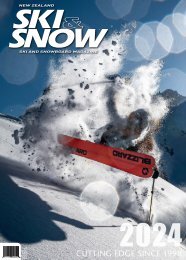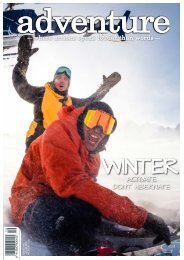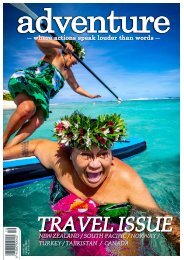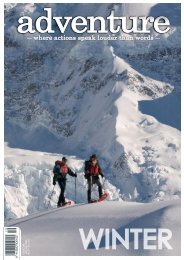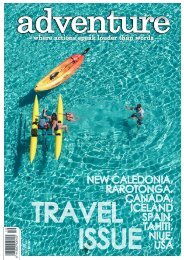Adventure Magazine Issue 220
Issue 220: June/July Winter 2020
Issue 220: June/July
Winter 2020
Create successful ePaper yourself
Turn your PDF publications into a flip-book with our unique Google optimized e-Paper software.
The Tongariro River:<br />
Hinemaiaia:<br />
Tauranga-Taupo:<br />
Sunrise on the Tongariro River - Image compliments of Great Lake Taupo<br />
The Tongariro River near Turangi has won<br />
a well-deserved reputation as one of the<br />
world's foremost fishing experiences. In<br />
winter, an estimated 10,000 rainbows and<br />
over 1000 browns migrate up it to reach<br />
the spawning beds.<br />
The river is wide and fast-flowing in places,<br />
with long gravel runs, rocky stretches<br />
and deep lies but there is easy access,<br />
even directly off the motorway. The fishing<br />
pools are not only historic but legendary<br />
among angler worldwide: Major Jones,<br />
The Admiral's Pool, The Judge's Pool, The<br />
Hydro, Red Hut, Kamahi, The Duchess...<br />
During rainbow trout migrations<br />
out of lake Taupo through<br />
April to September the lower<br />
Hinemaiaia offers great fly<br />
fishing, especially. The river<br />
generally runs very clear and is<br />
ideal for nymphing as well as<br />
dry and wet fly. Its banks are<br />
overgrown, but trails give good<br />
access. The fish often lie deep<br />
and close to the bank, making<br />
them a challenge to cast too.<br />
The middle reaches of<br />
the 'TT' as it is called offer<br />
easy access off the main<br />
highway and casting and<br />
good fish between March<br />
and September for dry, lure<br />
and nymph fishing. In places<br />
the bank is very high, and it<br />
is easy to see trout laying in<br />
the deeper pools.<br />
Guided Fly Fishing:<br />
The Big Lake:<br />
Te Whaiau Canal:<br />
Whanganui:<br />
Regardless your ability to fly-fish,<br />
highly skilled or novice, fishing lake<br />
or river you will have something to<br />
meet your budget and time frame.<br />
Whether it’s a half day learning on<br />
the bank of the Tongariro river for<br />
first timers or a day trolling around<br />
Lake Taupo with the family, there is<br />
something for everyone.<br />
Local guides know where to go,<br />
what to use and how to use it. From<br />
half day introduction package to<br />
full week away in the hills, drive in<br />
– walking or even helicopter. Most<br />
guides will provide all the gear and<br />
organise a licence. Be prepared<br />
most guides will not let you keep the<br />
fish you catch but you will get some<br />
great memories and photos.<br />
New Zealand's largest lake (surface area of 616sq<br />
km) is situated in the middle of the North Island on a<br />
volcanic plateau 359 metres above sea level. Due to<br />
its very cold clean water and abundant food sources it<br />
produces huge numbers of well-conditioned fish. It is<br />
very deep in places (up to 185 metres) but has many<br />
areas that provide excellent shoreline fishing. Some<br />
of the best areas for shoreline angling are around the<br />
many stream mouths where fish congregate during the<br />
warmer months and to which they migrate during the<br />
winter spawning runs.<br />
The most popular method for fishing the lake is trolling,<br />
including leadline trolling, wire lining, or the use of<br />
downriggers to troll at a deeper level. Jigging the dropoffs<br />
and fly-fishing around the lake shore and at river<br />
mouths are also popular methods (though note that<br />
boat fishing is not permitted around many of the points<br />
where rivers and streams enter the lake).<br />
The Te Whaiau Canal is short slow<br />
moving and deep. It generally<br />
has steep banks with quite dense<br />
vegetation coming down to the<br />
water’s edge. There are few areas<br />
however where the land opens up<br />
allowing for good casting. Much of<br />
the length of this water is difficult<br />
to both find a good place to stand<br />
and cast from. The fish numbers,<br />
particularly early and late in the<br />
season can be very high and the<br />
fish tend to free risers. During the<br />
warmer months they can often be<br />
seen chasing emerging insects.<br />
That said they are often very difficult<br />
to fool and will rise close to anglers<br />
yet reject even the most beautifully<br />
presented fly.<br />
The upper river rises in the Tongariro National Park and<br />
connects with Lake Otamangakau and the Whakapapa river.<br />
It runs through beautiful native forest, spectacular gorges and<br />
farmland. This river has a reputation for rising quickly so it<br />
pays to keep an eye on the weather forecast. The Wanganui<br />
river generally clear, easy to fish and contains a good number<br />
of trout and is renowned to have some large specimens.<br />
Whakapapa:<br />
The Whakapapa is a large, clear river with some wild rapids,<br />
deep pools and long boulder runs that flows down from<br />
Mt Ruapehu it runs through rugged country which is not<br />
advisable for the inexperienced. Lower down it features many<br />
kilometres of spectacular and productive wilderness fishing.<br />
But the upper reaches you need to know what you are doing<br />
and again be watchful of the weather.<br />
Trout fishing anywhere in the world give you great access to<br />
some of the most unique and beautiful aspect of the country.<br />
But trout fishing in the Central Plateau is like nowhere else it is<br />
varied, spectacular, full of history and legend. It offer something<br />
for everyone, from kids fishing at the Turangi Trout Farm to heli<br />
trip to the back of beyond. Your only limitation is time.<br />
50//WHERE ACTIONS SPEAK LOUDER THAN WORDS/#<strong>220</strong> ADVENTUREMAGAZINE.CO.NZ 51




